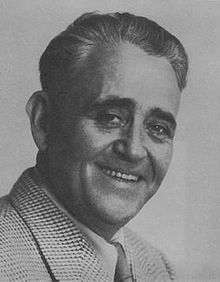Joseph Conrad Chamberlin
| Joseph Conrad Chamberlin | |
|---|---|
 | |
| Born |
December 23, 1898 Salt Lake City |
| Died |
July 17, 1962 (aged 63) Hillsboro, Oregon |
| Fields | Arachnology |
| Institutions | United States Department of Agriculture |
| Alma mater | Stanford University |
| Known for | Pseudoscorpion taxonomy |
Joseph Conrad Chamberlin (December 23, 1898 – July 17, 1962) was an American arachnologist who studied mainly pseudoscorpions. A native of Utah, he studied primarily at Stanford University while working most of his career in Oregon for the U.S. Department of Agriculture. Several are species named in his honor.
Early life
Chamberlin was born in Salt Lake City, Utah to Ole Chamberlin and Mary Ethel (Conrad) Chamberlin.[1] His parents were descended from early Mormon pioneer families, and he was their first child. Joseph's father died in 1911, leaving the remaining five person family near poverty. After one year of high school, he left school in 1914 to work in order to support the family.[1] In October 1918, Joseph was drafted into the United States Army, but fell ill with the Spanish flu pandemic and never served in World War I.[1]
After recovering, Chamberlin began college at the University of Utah when Congress allocated funding for veterans. Originally a one-year program, Congress expanded it to cover four years of school and Chamberlin transferred to Stanford University upon the recommendation of his uncle, Ralph Vary Chamberlin.[1] He was accepted as a special case, and studied entomology in the Zoology Department. His tutor at Stanford University was Gordon Floyd Ferris, an internationally reputed entomologist at the time. Chamberlin graduated in 1923 with a BA degree, and in 1924 with a master's degree.[1]
Career
Chamberlin began teaching after college at San Jose State University before earning a PhD from Stanford in 1929.[1] That year, he began working for the United States Department of Agriculture. His first assignment with the Department was in Idaho, where he worked until transferring to Modesto, California in 1935. In 1936, he moved to Oregon, where he worked at a field station in Corvallis.[1] In 1939, Chamberlin transferred to the Forest Grove, Oregon station where he remained until 1961. He died in Hillsboro, Oregon.[1]
Two genus-group names and eleven species have been named after him.[2] He would describe several species while working with his uncle. Joseph married Clara Hya Gladstone in 1923 and they had 5 children. They divorced and he remarried Charlotte May in 1944, 6 years after his divorce.
Eponymous taxa
Pseudoscorpions
The following pseudoscorpion taxa (species, genera, or subgenera) have been named for Chamberlin.[2]
- Apocheiridium chamberlini Godfrey 1927
- Fissilicreagris chamberlini (Beier 1931)
- Afrosternophorus chamberlini (Redikorzev 1938)
- Haploditha chamberlinorum Caporiacco 1951*
- Kleptochthonius (Chamberlinochthonius) Vachon 1952
- Pararoncus chamberlini (Morikawa 1957)
- Larca chamberlini Benedict & Malcolm 1978
- Cheiridium chamberlini Dumitresco & Orghidan 1981
- Chthonius chamberlini (Leclerc 1983)
- Chamberlinarius Heurtault 1990
- Hya chamberlini Harvey 1993
- Tyrannochthonius chamberlini Muchmore 1996
- Anysrius chamberlini Harvey 1998
- Rhopalochernes chamberlini Heurtault 1998
- *Named for J. Chamberlin and R.V. Chamberlin
Other taxa
Besides pseudoscorpions, other taxa named for Chamberlin include:[1]
- Bulimulus chamberlini Hanna (Gastropoda)
- Centrioptera chamberlini Blaisdell (Tenebrionidae)
- Euagrus josephus R.V. Chamberlin (Araneae, Dipluridae)
- Euphorbia chamberlini I.M.Johnston (Euphorbia)
- Ticida chamberlini Van Duzee (Hemiptera, Dictyopharidae)
- Triphora chamberlini F. Baker, 1926 (Gastropoda, Triphoridae)[3]
See also
- William Henry Chamberlin (philosopher) - another uncle, brother of Ralph
References
- 1 2 3 4 5 6 7 8 9 Judson, Mark & Chamberlin, David C. (1998): Joseph C. Chamberlin 1898-1962. The Journal of Arachnology 26(3): 411-418.
- 1 2 Harvey, Mark S. & Judson, Mark (1998): A Tribute to Joseph C. Chamberlin on the occasion of the 100th anniversary of his birth. Preface. The Journal of Arachnology 26(3): 409-410.
- ↑ Hans G. Hansson (1997-11-14). "Biographical Etymology of Marine Organism Names (BEMON)". Tjärnö Marine Biological Laboratory, Göteborg University.
Further reading
- A Tribute to Joseph C. Chamberlin The Journal of Arachnology 26(3): 409-459.